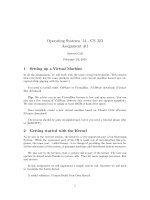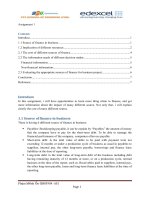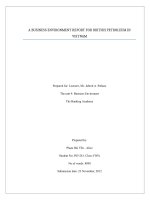1639 assignment 1 (merit)
Bạn đang xem bản rút gọn của tài liệu. Xem và tải ngay bản đầy đủ của tài liệu tại đây (909.47 KB, 78 trang )
ASSIGNMENT 1 FRONT SHEET
Qualification
BTEC Level 5 HND Diploma in Computing
Unit number and title
Unit 13:Computing Research Project
Submission date
23/02/2023
Date
Received
submission
1st 23/02/2023
Re-submission Date
09/03/2023
Date
Received
submission
2nd 09/03/2023
Student Name
DAO VINH KHANG
Student ID
GCS200222
Class
GCS0905B
Assessor name
Mathivanan Sharmila
Student declaration
I certify that the assignment submission is entirely my own work and I fully understand the
consequ making a false declaration is a form of malpractice.
Student’s signature
Grading grid
P1
P2
P3
P4
P5
M1
M2
M3
D1
D2
ASSIGNMENT 1 BRIEF
Qualification
BTEC Level 5 HND Diploma in Computing
Unit number
UNIT 13: Computing Research Project
Assignment title
Proposing and conducting a research project
Academic Year
2022 - 2023
Unit Tutor
Do Tien Thanh
Issue date
03 August 2022
IV name and date
Submission
date
03 August 2022
Submission Format:
Format:
The submission is in the form of 1 document
You must use font Calibri size 12, set number of the pages and use multiple line
spacing at 1.3. Margins must be: left: 1.25 cm; right: 1 cm; top: 1 cm and bottom: 1
cm. The reference follows Harvard referencing system.
Submission
Students are compulsory to submit the assignment in due date and in a way
requested by the Tutors. The form of submission will be a soft copy posted on
/>Note:
The Assignment must be your own work, and not copied by or from another student
or from
books etc. If you use ideas, quotes or data (such as diagrams) from books, journals or other
sources, you must reference your sources, using the Harvard style. Make sure that you know how
to reference properly, and that understand the guidelines on plagiarism. If you do not, you definitely
get failed
Unit Learning Outcomes:
LO1 Examine appropriate research methodologies and approaches as part of the research process
LO2 Conduct and analyse research relevant for a computing research project
LO3 Communicate the outcomes of a research project to identified stakeholders
Assignment Brief and Guidance:
Introduction to theme
The environmental impact of digital transformation
The amount of data created and stored globally is expected to reach 175 Zettabytes by 2025, a
six-fold increase from 2018. This will demand additional hardware and power consumption, which;
in turn, will increase the environmental impact of the digital sector and there is already increasing
attention on the environmental footprint of ICT equipment and services as they become more
widespread in all aspects of human life.
It is the responsibility of everyone to take action in addressing the challenges of climate change,
as professionals we must also seek ways that the digital sector can play its part. While digital
technologies are one of the sectors that has achieved greater efficiency; achieving about 100
times more computation power from the same amount of energy per decade, it remains
unsustainable. The sector must continue to seek ways in which it can continue to support and
drive innovation, while addressing the global climate emergency for a greener and fairer future.
Choosing a research objective/question
Students are to choose their own research topic for this unit. Strong research projects are those
with clear, well focused and defined objectives. A central skill in selecting a research objective is
the ability to select a suitable and focused research objective. One of the best ways to do this is
to put it in the form of a question. Students should be encouraged by tutors to discuss a variety of
topics related to the theme to generate ideas for a good research objective.
The range of topics discussed could cover the following:
● The use of modern methods to reduce carbon emissions in IT network systems.
● The impact of cloud data centres on the environment.
● The environmental implications of e-waste and ways to reduce it.
The research objective should allow students to broaden their understanding and widen their
erspective of being able to explore, argue, prove, and/or disprove a particular objective. The
research objective should be feasible, novel, ethical, relevant and ultimately of interest to the
student
You have to set you own research question in the research proposal base on the previous range
of topic, and the research question must be specific enough.
Learning Outcomes and Assessment Criteria
Pass
Merit
Distinction
LO1 Examine appropriate research methodologies and approaches as part of
the research process
P1 Produce a research proposal that
clearly defines a research question or
hypothesis supported by a literature
review.
M1 Evaluate different research
approaches and methodology and
make justifications for the choice of
methods
selected
based
on
philosophical/theoretical frameworks.
P2 Examine appropriate research
methods and approaches to primary
and secondary research.
LO1 & 2
D1 Critically evaluate research
methodologies and processes in
application to a computing research
project to justify chosen research
methods and analysis.
LO2 Conduct and analyse research relevant for a computing research project
P3 Conduct primary and secondary M2 Discuss merits, limitations and
research using appropriate methods pitfalls of approaches to data
for a computing research project that collection and analysis.
consider costs, access and ethical
issues.
P4 Apply appropriate analytical tools,
analyse research findings and data.
LO3 Communicate the outcomes of a research project to identified
stakeholders
D2
Communicate
critical
analysis of the outcomes and
P5 Communicate research outcomes
in an appropriate manner for the
intended audience.
M3
Coherently
and
logically
communicate outcomes to the
intended audience demonstrating
how outcomes meet set research
objectives.
make
valid,
recommendations.
justified
Summative Feedback:
Grade:
Internal V
Resubmission Feedback:
Assessor Signature:
erifier’s
Signature & Date:
Comments:
Date:
Contents
Grading grid ................................................................................................................................................................. 1
Choosing a research objective/question ........................................................................................................................ 4
P1 Produce a research proposal that clearly defines a research question or hypothesis supported by a literature review.
........................................................................................................................................................................................ 10
I. Introduction ............................................................................................................................................................... 10
1. Project Scopes ..................................................................................................................................................... 12
2. Main aims ............................................................................................................................................................. 13
3. The research will do and don’t.............................................................................................................................. 14
4. Project Objectives ................................................................................................................................................ 14
II. Literature Review ..................................................................................................................................................... 16
1. Research Methodologies ...................................................................................................................................... 18
2. Research Methods Implemented.......................................................................................................................... 26
3. Secondary Research ............................................................................................................................................ 27
4. Conclusion ........................................................................................................................................................... 30
P2 Examine appropriate research methods and approaches to primary and secondary research. ................................. 30
III. Primary Research ................................................................................................................................................... 30
1. Interview ............................................................................................................................................................... 30
2. Survey .................................................................................................................................................................. 36
P3 Conduct primary and secondary research using appropriate methods for a computing research project that consider
costs, access and ethical issues. .................................................................................................................................... 43
V. Research Proposal .................................................................................................................................................. 43
Research Ethics Approval Form ..................................................................................Error! Bookmark not defined.
P4 Apply appropriate analytical tools, analyse research findings and data ..................................................................... 60
IV. Analyze the result of the Primary research ............................................................................................................. 60
1. Interview ............................................................................................................................................................... 60
2. Survey .................................................................................................................................................................. 60
P5 Communicate research outcomes in an appropriate manner for the intended audience. ........................................... 73
Conclusion ................................................................................................................................................................... 73
References ...................................................................................................................................................................... 77
P1 Produce a research proposal that clearly defines
a research question or hypothesis supported by a
literature review.
Research Proposal Title: Environmental Carbon Footprint of Data Centers in
Indian IT Parks
I. Introduction
Digital transformation has brought about significant changes in the way individuals and organizations live, work, and
produce, largely based on digital technologies. Cloud data centers have played a major role in this transformation, but
their impact on the environment cannot be ignored, especially in the context of Indian IT parks.
Cloud data centers have the potential to promote energy efficiency and reduce the carbon footprint of computing in Indian
IT parks. By optimizing their data centers and adopting renewable energy sources, such as wind or solar power, cloud
providers can make significant strides in reducing their carbon emissions. Furthermore, the adoption of cloud services
can help businesses in Indian IT parks minimize their physical infrastructure, leading to lower energy and resource
consumption.
However, it is important to acknowledge the negative environmental impacts associated with cloud data centers in Indian
IT parks. The construction, maintenance, and operation of data centers require substantial amounts of energy, water, and
other resources. Cooling systems, in particular, consume significant amounts of water and energy. If data centers in Indian
IT parks rely on fossil fuels for power generation, they can contribute to air and water pollution, as well as greenhouse
gas emissions.
To mitigate the environmental carbon footprint of data centers in Indian IT parks, several measures can be taken. Firstly,
there should be a focus on optimizing the energy efficiency of data centers through the use of advanced cooling
technologies, efficient server architectures, and power management systems. Secondly, the adoption of renewable energy
sources, such as solar or wind, should be encouraged to power data centers in Indian IT parks. This will help reduce
dependence on fossil fuels and lower greenhouse gas emissions. Additionally, water conservation measures should be
implemented to minimize the water consumption of data centers in Indian IT parks.
Furthermore, promoting sustainable practices and raising awareness among cloud providers, businesses, and
stakeholders in Indian IT parks is crucial. Encouraging the use of energy-efficient hardware, implementing virtualization
techniques to optimize server utilization, and adopting best practices for data center design and operation can all
contribute to reducing the environmental impact of data centers.
In conclusion, while cloud data centers have the potential to promote energy efficiency and reduce the carbon footprint of
computing in Indian IT parks, their negative environmental impacts should not be ignored. By implementing energyefficient practices, adopting renewable energy sources, and raising awareness about sustainable operations, the
environmental carbon footprint of data centers in Indian IT parks can be mitigated.
1. Project Scopes
In this review on the environmental carbon footprint of data centers in Indian IT parks, we will explore the implications of
digital transformation in document storage and its impact on the data storage industry. Specifically, we will examine the
benefits and importance of digital transformation in replacing traditional libraries with digital formats. However, it is
important to acknowledge that digital transformation also brings about environmental harm due to data redundancy.
2. Main aims
In this review on the environmental carbon footprint of data centers in Indian IT parks, the study will be structured around
two main objectives:
Analyzing the advantages and disadvantages of digital transformation compared to traditional libraries in data storage:
The review will assess the benefits and drawbacks of digital conversion in the context of data storage, particularly in Indian
IT parks. This analysis will consider factors such as accessibility, space utilization, scalability, and ease of data
management. The aim is to provide a comprehensive understanding of the impact of digital transformation on the data
storage industry.
3. The research will do and don’t
In conducting a review on the environmental carbon footprint of data centers in Indian IT parks, the research will follow
certain do's and don'ts to ensure a comprehensive and reliable study. Here are some guidelines for the research:
Do's:
Conduct thorough secondary research: Explore existing literature, academic papers, industry reports, and relevant
publications to gather a comprehensive understanding of the environmental carbon footprint of data centers in Indian IT
parks. This will provide a solid foundation for the review.
Collect accurate and reliable data: Utilize primary research methods, such as surveys, interviews, and data collection, to
gather specific and reliable information regarding the carbon emissions, energy consumption, and sustainability practices
of data centers in Indian IT parks. Ensure data accuracy and integrity through proper research methodologies.
Use recognized carbon footprint assessment methodologies: Apply recognized and accepted carbon footprint assessment
methodologies, such as the Carbon Disclosure Project (CDP) or the Greenhouse Gas Protocol, to calculate and evaluate
the carbon emissions of data centers accurately. This will ensure consistency and reliability in the research findings.
Analyze and compare data centers: Perform a comparative analysis of different data centers in Indian IT parks to assess
their environmental performance. Compare energy efficiency, renewable energy adoption, and carbon reduction
strategies to identify best practices and areas for improvement.
Provide actionable recommendations: Based on the research findings and analysis, offer practical and actionable
recommendations for reducing the environmental carbon footprint of data centers in Indian IT parks. These
recommendations should focus on energy efficiency measures, renewable energy integration, waste reduction strategies,
and sustainable practices that can be implemented by data centers.
Don'ts:
Rely solely on anecdotal evidence: Avoid basing conclusions or recommendations solely on anecdotal evidence or
personal opinions. Ensure that the research is grounded in empirical data and supported by credible sources.
Overgeneralize findings: Be cautious of overgeneralizing findings from a limited sample size or specific data centers.
Recognize the diverse nature of data centers in Indian IT parks and consider the unique characteristics of each facility
when drawing conclusions.
Neglect the context: Consider the specific context of Indian IT parks and their environmental and regulatory frameworks.
Ensure that the research findings and recommendations align with the local conditions and requirements to be relevant
and feasible.
Ignore emerging trends and technologies: Stay up-to-date with emerging trends and technologies in the data center
industry. Consider the potential impact of innovative solutions such as edge computing, energy-efficient cooling systems,
or renewable energy integration when analyzing the environmental carbon footprint of data centers.
By adhering to these do's and don'ts, the research on the environmental carbon footprint of data centers in Indian IT parks
can provide reliable insights and actionable recommendations for promoting sustainability in the industry.
4. Project Objectives
In this review on the environmental carbon footprint of data centers in Indian IT parks, the following steps will be
undertaken to analyze the problem, purpose, main aims, and project objectives:
Problem analysis: The problem at hand is the environmental impact of data centers in Indian IT parks, specifically
focusing on their carbon footprint. The purpose of the review is to assess the extent of this impact and identify areas for
improvement. The main aims are to understand the environmental challenges associated with data centers, explore the
existing practices in Indian IT parks, and propose recommendations for reducing their carbon footprint.
Research methods: The review will utilize both primary and secondary research methods to gather relevant information.
Secondary research: Conducting secondary research involves gathering information from existing sources, such as
academic papers, industry reports, and government publications. This will provide a comprehensive understanding of the
environmental carbon footprint of data centers in Indian IT parks, including their energy consumption, greenhouse gas
emissions, and water usage.
Primary research: Primary research will be conducted to supplement the findings from secondary research. This may
involve surveys, interviews, or data collection from Indian IT parks to gather specific insights into their data center
operations, energy sources, and environmental sustainability initiatives.
Analysis based on secondary data: The collected secondary data will be analyzed to evaluate the current state of
environmental carbon footprint in Indian IT parks. This analysis will identify key contributors to carbon emissions, resource
consumption, and potential areas for improvement.
Reviews and conclusions: Based on the analysis of both secondary and primary research data, reviews and conclusions
will be formulated. These will highlight the significant findings, key challenges, and potential solutions to reduce the
environmental carbon footprint of data centers in Indian IT parks.
Other documents: Along with the review, other supporting documents such as data tables, charts, and references will
be provided to enhance the credibility and understanding of the research.
II. Literature Review
Literature Review: Environmental Carbon Footprint of Data Centers in Indian IT Parks
The environmental carbon footprint of data centers in Indian IT parks has gained significant attention in recent years due
to the rapid growth of the IT industry and the increasing demand for data storage and processing. This literature review
aims to summarize and analyze the key concepts, theories, studies, debates, and gaps in existing knowledge related to
this topic.
Key Concepts and Theories:
Several key concepts and theories are relevant to understanding the environmental carbon footprint of data centers in
Indian IT parks. These include:
Energy Efficiency: Studies have emphasized the importance of energy-efficient design and operations in reducing the
carbon emissions of data centers. Concepts such as Power Usage Effectiveness (PUE) and Energy Reuse Effectiveness
(ERE) have been widely discussed in the literature.
Renewable Energy Integration: The integration of renewable energy sources, such as solar and wind power, into data
center operations has been proposed as a sustainable solution to reduce carbon emissions. The literature explores the
challenges and benefits of adopting renewable energy in Indian IT parks.
Cooling Techniques: Efficient cooling systems play a vital role in reducing the energy consumption and carbon footprint
of data centers. The literature discusses various cooling techniques, including air-side economization, liquid cooling, and
free cooling, and their impact on energy efficiency.
Key Debates and Controversies:
The environmental carbon footprint of data centers in Indian IT parks has also sparked debates and controversies. These
include:
Trade-Offs between Energy Efficiency and Performance: There is a debate regarding the trade-offs between energy
efficiency measures and the performance and reliability of data centers. Some studies argue that aggressive energysaving strategies may compromise the performance of data centers, while others propose innovative solutions to strike a
balance.
Data Center Location and Greenfield vs. Brownfield Development: The choice of data center location and the preference
for greenfield (building new data centers) or brownfield (repurposing existing buildings) development have been subjects
of debate. The literature discusses the environmental implications of these decisions and explores strategies for
sustainable data center site selection.
Gaps in Existing Knowledge:
While significant research has been conducted on the environmental carbon footprint of data centers globally, there are
still gaps in the understanding of this issue specifically in Indian IT parks. Some of the notable gaps include:
Limited Studies on Indian IT Parks: The literature review reveals a scarcity of studies specifically focused on Indian IT
parks. Most research has been conducted in developed countries, and there is a need for more empirical studies in the
context of Indian IT parks to assess their unique environmental challenges and potential solutions.
Lack of Long-Term Environmental Impact Assessments: The long-term environmental impact of data centers in Indian IT
parks is an area that requires further investigation. There is a need for studies that assess the carbon footprint of data
centers over extended periods and evaluate the effectiveness of sustainable practices and technologies implemented.
Policy and Regulatory Frameworks: The literature highlights the need for a robust policy and regulatory framework to
promote sustainable practices in Indian IT parks. However, there is limited research on the effectiveness of existing
policies and the potential barriers to their implementation.
In conclusion, this literature review provides an overview of the key concepts, theories, debates, and gaps in knowledge
concerning the environmental carbon footprint of data centers in Indian IT parks. It highlights the importance of energy
efficiency, renewable energy integration, and cooling techniques in reducing carbon emissions. The review also identifies
debates regarding energy efficiency trade-offs and data center location choices. Furthermore, it emphasizes the need for
more research specific to Indian IT parks and long-term environmental impact assessments, as well as the development
of effective policy and regulatory frameworks.
1. Research
Methodologies
In conducting a review on the environmental carbon footprint of data centers in Indian IT parks, the following
methodologies can be utilized:
Secondary research: This method involves gathering information from existing sources such as academic papers,
industry reports, government publications, and reputable online sources. The secondary research will focus on
understanding the environmental impact of data centers, carbon footprint assessment methodologies, energy
consumption trends, and sustainability practices in Indian IT parks. It will provide a foundation of knowledge and help
identify key areas of focus for the review.
Data collection: Primary research can be conducted to collect specific data related to data centers in Indian IT parks.
This can involve surveys, interviews, and data collection from relevant stakeholders, including data center operators, IT
park management, and environmental sustainability organizations. The primary research will provide valuable insights
into the actual carbon emissions, energy consumption patterns, and environmental initiatives implemented in Indian IT
parks.
Carbon footprint analysis: Once the data is collected, a carbon footprint analysis can be conducted. This analysis
involves quantifying the greenhouse gas emissions associated with the energy consumption, cooling systems, and overall
operations of data centers in Indian IT parks. Various calculation methodologies, such as the Carbon Disclosure Project
(CDP) or the Greenhouse Gas Protocol, can be applied to assess the carbon footprint accurately.
Comparative analysis: A comparative analysis can be performed to evaluate the environmental performance of different
data centers in Indian IT parks. This can include benchmarking energy efficiency, renewable energy adoption, and carbon
reduction strategies across multiple facilities. The analysis can highlight best practices and identify areas for improvement
to reduce the carbon footprint of data centers in Indian IT parks.
Literature review and synthesis: The findings from both secondary and primary research can be synthesized and
reviewed to draw meaningful conclusions. A comprehensive literature review can be conducted to examine existing
studies, case studies, and reports on the environmental carbon footprint of data centers in Indian IT parks. This review
will contribute to the understanding of the current state, challenges, and potential solutions in this context.
Recommendations: Based on the analysis and synthesis of research findings, specific recommendations can be
proposed to mitigate the environmental carbon footprint of data centers in Indian IT parks. These recommendations may
include strategies for energy efficiency improvements, renewable energy adoption, waste reduction, water conservation,
and sustainable practices.
By employing these methodologies, a comprehensive review can be conducted to assess the environmental carbon
footprint of data centers in Indian IT parks, identify challenges and opportunities, and provide actionable recommendations
for a more sustainable future.
Benefits of Survey:
•
Cost: Surveys are a cost-effective method. In particular, online and mobile surveys have a very small cost per
respondent. Even when incentives are given to respondents, the cost per response is often much less than the
cost of conducting a paper survey or a phone survey, and the number of potential responses can be as high as
thousands.
•
Extensive: Surveys are useful in characterizing a large population. No other research method can provide this wide
range of capabilities, ensuring a more accurate sample to collect targeted results for key decision-making and
conclusions.
•
Flexible: Surveys can be conducted in many modes, including: online survey, email survey, social media survey,
paper survey, mobile survey, web survey phone calls and face-to-face interviews.
• Dependable:
The
Getting to know the candidate and
Experiencing uncertain outcomes
yourself well
anonymity of surveys
Verifying candidate's facts
Experiencing improved customer bonds
allows respondents to
Differentiating similar candidates
respond with more
candid and valid answers. To get the most accurate data, you need respondents to be as open and honest as
possible with their answers.
Interview
An interview is a method of gathering information from a person through verbal responses to oral questions. It includes
many methods such as:
• Individual and group interviews Situational interviews
• Formal and informal interviews
Advantages
Disadvantages
•
Selecting the ideal candidates for the position
•
•
Conducting detailed evaluations
Navigating personal biases
•
•
Judging individuals too quickly
Creating stereotypes can create several challenges
during an interview.
Secondary research
In this review on the environmental carbon footprint of data centers in Indian IT parks, the study will be focused on the
following objectives:
Assessing the environmental advantages and challenges of digital transformation in data storage: The review will analyze
the environmental benefits and drawbacks of digital conversion as compared to traditional storage methods, specifically
in the context of data centers in Indian IT parks. Factors such as energy consumption, carbon emissions, resource
utilization, and waste generation will be examined to understand the environmental impact of digital transformation in the
data storage industry.
Evaluating the carbon footprint of data centers in Indian IT parks: The review will examine the carbon emissions and
environmental impact of data centers located within Indian IT parks. This analysis will include assessing energy
consumption patterns, cooling systems efficiency, utilization of renewable energy sources, and waste management
practices. By quantifying the carbon footprint, the review aims to provide insights into the environmental sustainability of
data centers in Indian IT parks.Scientific methods
The scientific method is the process of establishing facts objectively through examination and experimentation. The basic
process involves making observations, forming hypotheses, making predictions, conducting experiments, and finally
analyzing the results. The principles of the scientific method can be used in a variety of contexts, including business,
technology, and scientific research.
Research processes
The process of undertaking a research project is a series of steps in a circle, with each step dependent on the previous
one.
•
Step 1: Identify a Research Problem
To define a research problem, first select a general topic of interest to you as well as the interests and expertise of
your research advisor. Clearly defining the problem will guide the entire research in the
right direction and achieve the intended purpose.
•
Step 2: Review the Literature
Find out what is being asked or what has been done in the area by doing research methods. It will help shape the
research problem in light of certain unexplored features of the practitioner's overall area of interest.
•
Step 3: Determine Research questions, Objectives and Hypothesis
An objective will specify what needs to be assessed, outline the types of data to be collected, and provide guidelines
for the scope of the study. Using and testing a research hypothesis is the ideal way to describe a research objective.
A hypothesis is an unverified assertion or statement that can be disproved or confirmed by empirical evidence. The
hypothesis statement makes an assertion about a potential solution to a research topic.
•
Step 4: Choosing the Research Design
Researchers use different designs to accomplish different research objectives. This project is a master plan outlining
techniques and steps to be taken to collect, process and evaluate data. There are four basic study designs that can
be used by researchers to conduct their research.
•
Step 5: Deciding on the Sample Design
•
Step 6: Collecting Data and Analyze
Collect data from survey methods, interviews and document sources.
•
Step 7: Writing Research Report
Based on the analysis of the collected data to write the report.









